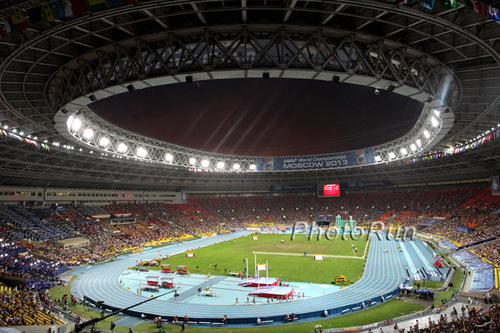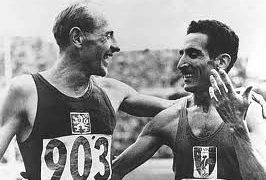World Championships, Day 3: “Chempionat po Lyogkoi Atletike!”
by M. Nicole Nazzaro
So, how does track translate “po-russki” (in Russian)?
After a gangbusters first 48 hours at the 2013 world championships in Moscow, filing seven stories, and topped off by a 1 a.m. dinner last night at one of the many “kruglosutochno” (around the clock, i.e. 24/7) restaurants near our hotel, today was a day to relax a bit and catch up on a bit of Russian track and field terminology. If ever you want to, say, travel to Russia for a track meet – and oh, how the meet organizers wish you’d done that this week, with the sparse attendance and ticket giveaways we’ve seen at Luzhniki Stadium – here’s a quick guide to how to talk about your favorite “vid sporta” (literally, “sport view,” or type of sport).
Let’s take this morning’s session as an example.
Today was the first day of the “semibor’ye” – heptathlon. “Sem'” is Russian for “seven”; the men’s counterpart event is the “desyatibor’ye” from “desyat'” (ten) – the decathlon. As the heptathlon’s first event, the 100 meters (“sto metrov”), began, almost immediately we saw the qualification round for the men’s “metanie diska” (discus) competition. Then came the first round for the men’s 3000-meter steeplechase (“tri tysyachi metrov s prepyatstviyami” – abbreviated “3000m s/p” in Russian, and if you look at how many consonants there are to navigate in that name, I don’t blame ’em for abbreviating it). You can also just call this one the “beg s prepyatstviyami” – “beg” means “run” in Russian (though I’d be begging for mercy if anyone ever made me run one of those races).
Back to the field events. At 10:35, the “prizhok v vysotu semibor’ye” (remember that word?) began: the “jumping for height” event – in other words, the heptathlon high jump. The second flight of the “metanie diska” began at 11:05, followed by the heats for the men’s and women’s 400-meter hurdles (another abbreviation: “400m s/b” for “chetiry tysyachi metrov s bar’yerami” – literally “with barriers”).
Are you following all of that? If so, “molodets”! (Good job!)
And to the evening session: beginning with the “tolkanie yadra semibor’ye” (heptathlon shot put) at 6:45 p.m., we move quickly to the final of the men’s “prizhok s shestom” (“jump with pole” – the pole vault). The 110m “s bar’yerami” (hurdles – you’re getting the hang of this, right?) men’s semifinals go off at 7:05 p.m., followed by the “sprinteri” (sprinters – in this case, the 100-meter and 400-meter women’s semis). The women’s “tolkaniye yadra” (shot put) and men’s “metanie molota” (hammer throw) follow, and at 8:35 p.m. the first day of the “semibor’ye” concludes with one more race: the 200m (“dvesti metrov”). The evening gets topped off with three straight “finali” (finals) in the women’s 400m, the men’s 110m hurdles, and the women’s 100m.
And in between all of that, don’t forget the occasional “tseremonia nagrazhdenia” (medal ceremony)!
If a “rossiski sportsmen” or “rossiskaya sportsmenka” (male or female Russian athlete) wins a medal, you can believe the “zriteli” (spectators) will be “ochen’ radi” (very happy) indeed. (Though there’s been quite a Ukrainian contingent here this week as well, so “ukrainskiye sportsmeni” have been receiving quite a few cheers themselves.)
Got it? “Khorosho” (good)! Now it’s already “pozno” (late). So get back to your “gostinitsa” (hotel) for a good night’s sleep and come back to the “stadion” (stadium) tomorrow on the “metro” (once in a while, Russian hands you a freebie). And don’t forget your “bilyeti” (tickets)!
“Do svidaniya” – “goodbye,” or in literal translation, “until we meet.” And we will – for another six days at the 2013 world track and field championships.
World Championships, Day 3: “Chempionat po Lyogkoi Atletike!” by M. Nicole Nazzaro
August 12, 2013
0
0
SHARES2
VIEWSSimilar Post
Leave a Reply Cancel reply
This site uses Akismet to reduce spam. Learn how your comment data is processed.
Subscribe to RunBlogRun's Global News Feed
Wake up to RunBlogRun’s news in your inbox. Sign up for our newsletter and we’ll keep you informed about the Sport you love.
*we hate spam as much as you do
- Trending
- Comments
- Latest
Popular Stories
Clyde Hart’s Guide to 400 meter training (from 1996 Super Clinic Notes/World Coaches Notes)
Noah Lyles, The Clock Doesn’t Lie
Abby Steiner replies via twitter, on the curiosity about her new professional running contract
An epic pole vault competition
Sha’Carri Richardson shows her rivals— and the athletics world — that she is number one
Recent Tweets
© 2022 Run Blog Run - All Rights Reserved






















